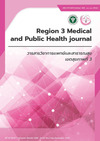Title Development of Tools to Enhance Efficiency of Patient care after External-Ventricular-Drainage Brain Surgery by Using Evidence-Based Ventricular Drainage and Innovation in Female Surgical Wards in Uthaithani Hospital.
Keywords:
Innovation, External ventricular drainage, EfficiencyAbstract
Objective : 1. To develop external ventricular drainage tools for drainage and pressure monitoring of the external ventricular drainage catheter of patients in a female surgical ward. 2. To study the efficiency of developed external ventricular drainage tools for patient care after external-ventricular-drainage brain surgery in female surgical wards.
Methods : The research and development method was applied to compare before and after the development of innovative tools used for caring for post-operative neurosurgery patients with external ventricular drainage. The relevant tools used include a traditional instrument, Innovation, readymade tools, and a questionnaire to assess the effectiveness of devices. The sample consists of 1) 13 Neurosurgeons and female surgical nurses in Uthai Thani Hospital and 2) 20 neurosurgery patients with external ventricular drainage insertion who were admitted to the female surgery unit in Uthaithani Hospital from July 2019 to October 2021. The reasons for selecting all samples to participate in this study were based on purposive criteria. Ten patients were divided into control group 1, who received traditional cerebrospinal fluid drip setting devices, and the other ten patients were applied innovative cerebrospinal fluid drip setting devices.
Data Analysis : Descriptive statistics included mean, standard deviations, and Inferential statistics. The Kruskall-Wallis Test was applied to compare timing used to set the level of cerebrospinal fluid dripping among former traditional tools, which were innovative tools and readymade tools, and The Mann-Whiney U test was applied to compares the efficiency of using between innovative tools and traditional tools. Set the level of statistical significance at p-value < 0.05.
Findings : The innovation device consists of 1) Using a laser pointer to set the cerebrospinal fluid drip level made the reference point more accurate and save time. 2) A ruler with a precise measuring scale ensured precision. 3) The bulb fasteners prevent it from slipping. 4) There was a basket to support the cerebrospinal fluid bag, making it secured. 5) cost-effective compared to the finished set EVD. Nurses and doctors who use this tool have opinions on the effectiveness of this tool at a very good and best level. This innovative tool used to set the cerebrospinal fluid dropping level can be practically used. When compared by using The Mann-whiney U statistics test, it was found that slippage of the cerebrospinal fluid dropping devices, the incidence of Increase intracranial pressure, and the time spent to set the level of cerebrospinal fluid dripping between the experimental group and the control group were different. The differences were statistically significant at p-value < 0.05.
Conclusion : The innovation tool consumed less time to set the Extenal ventricular drainage level. The laser pointer made it easier to set the reference point (Foramen of Monro) accurately. The Devices were easy to be installed, convenient to use, save time, and cost-effectiveness. To avoid the harmful effects of the laser light, patients’ eyes had to be closed every time before using the laser pointer.
Keywords : Innovation, External ventricular drainage, Efficiency.
References
ณัฏฐชา เจียรนิลกุล, เอก หังสสูต. ชุดสายระบายน้ำไขสันหลังรามาธิบดี. รามาธิบดีพยาบาลสาร 2547;10(3)193-203.
Mark S. Greenberg. Handbook of Neurosurgery (6 th ed.). New York : Thieme Medical Publishers. 2006.
Serarslan Y, Yilmaz A, Çakır M, Güzel E, Akakin A, Güzel A, et al. Use of programmable versus nonprogrammable shunts in the management of normal pressure hydrocephalus : a multicenter retrospective study with cost-benefit analysis in Turkey. Medicine (Baltimore).2017 Sep;96(39):e8185.
นิตยา อังพานิชเจริญ. เครื่องมือตั้งระดับจุดหยดน้ำไขสันหลัง. วารสารการพยาบาลศิริราช 2550; 1(2), 47-53.
ฉัตรกมล ประจวบลาภ. ภาวะความดันในกะโหลกศีรษะสูงในผู้ป่วยที่มีพยาธิสภาพที่สมอง : มิติของการพยาบาลตามหลักฐานเชิงประจักษ์. วารสารสภาการพยาบาล 2561; 33(2), 15-28.
Chan JW, Gombart ZJ, Rogers S, Gardiner SK, Cecil S & Bullock RM. Pupillary reactivity as an early indicator of increased intracranial pressure: the introduction of the Neurological Pupil Index. Surg Neurol Int 2011; 2(82), 1-7.
Fan JY. Effect of backrest position on intracranial pressure and cerebral perfusion pressure in individuals with brain injury: a systemic review, JNW 2004; 36(5), 278-88.
Sankhyan N, Raju V, Sharma S & Gulati S. Management of raised intracranial pressure. Indian. J pp Pediatr 2010; 77, 1409-16.
Pederson CM, Rosendahl-Nielsen M, Hjermind J & Egerod I. Endotracheal suctioning of the adult intubated patient- what is the evidence?. Intensive Crit Care Nurse 2009; 25, 21-30.
Downloads
Published
How to Cite
Issue
Section
License
Copyright (c) 2023 Region 3 Medical and Public Health Journal - วารสารวิชาการแพทย์และสาธารณสุข เขตสุขภาพที่ 3

This work is licensed under a Creative Commons Attribution-NonCommercial-NoDerivatives 4.0 International License.



